Store
Hours
|
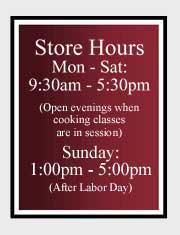
|
KA on
WTTV
|
| Just in case
you missed our latest TV segments on Ch. 7/WTVW, you
can still access the recipes at our website.
|
Bring a
Bag
|
BRING A BAG
-- SAVE A TREE --
FEED A FAMILY!
Over $400
raised so far!
Each time you make a
purchase and don't need a bag, or provide your own, we will donate
ten cents to the Tri-State Food Bank. If you don't need a bag, watch
us drop a dime in the jar on the counter. We thank you, and the
Tri-State's neediest families thank you, too.
ALL DONATIONS IN OUR JAR
WILL GO TO THE TRI-STATE FOOD
BANK! |
Mike's
Page
|
| Those who know
me, know that I enjoy musing and writing a bit. View "Mike's Page" at our
website. Check out the video - part of the "AHA Moment"
Project. Read
more. | |
|
Food to
Go!
|
Whether you're
off to work or school, preparing for lunch time is a daily dilemma!
Time and nutrition seem to be at odds in the process. After all, you
barely got breakfast out of the way! But the stars are aligned for
renewed energies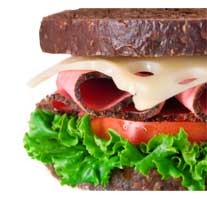 applied to packing your lunch. Yes, it's the back to school
time of year, but packing a great lunch is not just for kids
anymore! Packing your lunch saves money, shifts nutrition for
the better, and, in the end, saves time. A great lunch is the
perfect respite in the middle of a busy day and offers that
necessary refueling for the afternoon ahead. In this issue, we'll
offer a slew of tips for a better lunch and how to make it easy. We
complete our Knives 101 discussion with Part 2. A review and
three recipes from Tom Colicchio's new book, 'wichcraft
brings fresh inspiration to sandwich-making and, therefore,
lunch-making!
applied to packing your lunch. Yes, it's the back to school
time of year, but packing a great lunch is not just for kids
anymore! Packing your lunch saves money, shifts nutrition for
the better, and, in the end, saves time. A great lunch is the
perfect respite in the middle of a busy day and offers that
necessary refueling for the afternoon ahead. In this issue, we'll
offer a slew of tips for a better lunch and how to make it easy. We
complete our Knives 101 discussion with Part 2. A review and
three recipes from Tom Colicchio's new book, 'wichcraft
brings fresh inspiration to sandwich-making and, therefore,
lunch-making!
|
August
Special!
|
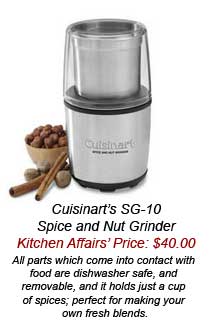 Cuisinart's Cuisinart's
Spice & Nut
Grinder
This grinder, a new and
terrific product from Cuisinart, will do a great job of
grinding herbs, freshly roasted spice seeds, even nuts, garlic and
ginger among other things. It also comes with a lid so you can save
the remainder of you spice or chile blend to use later. Best tool
we've seen in years for making spice blends, rubs, and small
quantities of wet rubs and salad dressings.
|
Cooking
Classes at Kitchen Affairs
|
We have some
excellent classes scheduled for this summer. Whatever your cooking
interest, there's mst likely a class for you! Check out our website to see the
entire Class Schedule and
complete class descriptions.
Click
on the class title for full information!
Call us at (812)
474-1131, or stop in the store to
register!
Thursday, Aug.
27 - 6:30 pm -
Luscious Summer Chicken
with Cindy
Vescovi.
$50
Tuesday,
Sept. 1 - 6:30 pm -
Menu for Early Fall
with Jason Watson.
$42
Wednesday,
Sept. 9 - 6:30 pm -
A Mexican Fiesta!
with Shelly Sackett.
$45
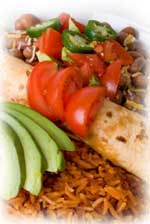
Thursday,
Sept. 10 - 6:30 pm -
Encrusted Chicken Dinner
with
Lowry Igleheart-Keach $45
Saturday,
Sept. 12 - 9:30 am -
Celebrity Chef Class: Southern
Specials!
with Virginia Willis. $55
Sunday,
Sept. 13 - 1:30 pm -
Celebrity Chef Class: Classic French
Techniques
with Virginia Willis.
$60
Tuesday,
Sept. 15 - 6:30 pm -
Let's Get Stewed!
with Scott Schymik.
$48
Check
our website, and call to reserve a place! (812) 474-1131!
| |
Build a Better
Lunch!
|
Looking for
motivation to upgrade your lunch habits? We have several good
reasons to offer that will help overcome some of the common
obstacles to packing a good lunch for yourself or for your
family.
 Stockpile
Some Cash - Even a simple lunch out can be $6-10. A
packed lunch from home can cost anywhere from $2-4. If you save
$4/day for 20 workdays per month, that's $80/month, or $960/year. To
paraphrase Will Rogers, this starts "to add up to some real money!" Stockpile
Some Cash - Even a simple lunch out can be $6-10. A
packed lunch from home can cost anywhere from $2-4. If you save
$4/day for 20 workdays per month, that's $80/month, or $960/year. To
paraphrase Will Rogers, this starts "to add up to some real money!"
Improve Your
Nutrition - Food is fuel! Lunch should provide no more than
one-third of your daily calories. High fat and/or high carbohydrate
lunches can easily exceed that one-third rule, and actually slow you
down for the afternoon. We're surrounded by high calorie and high
fat options everywhere! A Big Mac® contains 540 calories and 29
grams of fat; add a large fry and you're adding another 500 calories
and 25 more grams of fat. Even fast food salads with fat-laden
dressings can tip into the "too much" range. Lunch is a great chance
for making good on that intention to improve your diet. Planning
good food ahead of time and packing a lunch will provide better fuel
for your body!
Save
Time - Fast food really isn't all that fast! By the
time you drive or walk to the restaurant, wait in line, wait for
your order and drive back, at least 10-15 minutes have passed. A
great lunch can be packed at home in less than 10
minutes!
Use Less
Packaging - Packing a lunch in reusable containers avoids
fast food packaging and all of the waste that accompanies one quick
meal.

Fight Boredom with Creativity and
Variety - Lunch can be so much more than a peanut butter
sandwich and a side of carrot and celery sticks!
- Incorporate more
fruits and veggies in your lunch with grape tomatoes, cucumber
sticks, berries, grapes, broccoli "trees," or whatever's in
season.
- Avoid packing
processed foods - they're generally more expensive, have
questionable ingredients, are packaging intense, and often
nutritionally suspect with high sodium and preservatives.
- Have a quick Plan B
for those hurried mornings! A Plan B might include freezing
several sandwiches ahead of time, or individual portions of
previous suppers.
- Apportion tomorrow's
lunch before serving tonight's supper. You'll avert the risk of
there being no leftovers available after the meal.
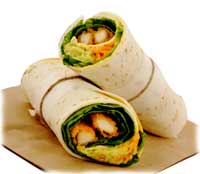 Enjoy
packing a good sliced bread sandwich, but don't forget about
wraps, pita bread, bagels, rice cakes, crackers, English muffins,
or croissants as sandwich foundations. Enjoy
packing a good sliced bread sandwich, but don't forget about
wraps, pita bread, bagels, rice cakes, crackers, English muffins,
or croissants as sandwich foundations.
- Make that apple more
enticing - slices (drizzled with a little lemon juice to prevent
browning) might be easier to handle at lunchtime. Include vanilla
yogurt for a quick dip, or a nut butter for smearing on the
fruit.
- What to drink? Skip
sugary drinks. Pack a lime or lemon slice to dress up tap water.
Perhaps some herbal tea - hot or cold. You could even rediscover
milk at lunch - we're told we all need more calcium and Vitamin
D.
- Watching your
calories? Packing your own lunch is a great start. Bring an
open-faced sandwich and you've sliced the bread calories in half.
Or, use a lettuce leaf for a sandwich wrapper.
- Explore bean spreads
(hummus, refried beans), tapenades, guacamole, or cream cheese
spreads with your own diced vegetable and fruit "mix-ins."
- A layer of wilted
greens sautéed in garlic is an easy solution for injecting leafy
green vegetables into your sandwich.
- Make lunch kebabs of
meat and cheese, veggies and fruits. You could even make some
antipasto on a stick!
- Make your own trail
mix - GORP - 'Good Ole' Raisins and Peanuts' - or any combination
of dried fruits, nuts, crunch, and sparkle (M & M's?).

- Investigate some
hearty salads - bean salads, meat salads, pasta salads, veggies
with pesto.
- Change the types of
bread used in sandwiches - rye, pumpernickel, oatmeal, baguette,
sesame - there are scores of bread choices. Similarly, vary your
choice of cheeses and meats.
- Dress up leftover rice
or pasta with nuts, herbs and a simple dressing of olive oil and a
flavored vinegar. Add a few leftover vegetables, and it's a
complete meal.
- Review the calorie
count and nutritional profile of your packed lunch - too little,
too much, or just
right?
|
Make It
Easy!
|
You're much
more likely to establish a habit of packing lunch if you have a plan
and the right set-up for food on the go! Set yourself up with
appropriate lunch tools!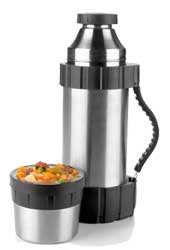
Thermoses - To keep hot foods hot,
and cold foods cold, use a thermos. This isn't just a matter of
having a pleasant food experience, it promotes food safety by
keeping foods out of the temperature range that promotes bacterial
growth. Beverage thermoses are typically tall and narrow, and often
double as drinking mugs. Many styles with stainless steel,
double-walled construction are available. Previously, thermoses
relied on glass inserts which had the nasty habit of
breaking.
Wide-Mouthed Thermoses - Shaped
differently, constructed similarly to other thermoses, these units
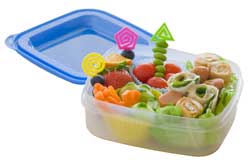 are perfect for
soups, stews, or your favorite chili. are perfect for
soups, stews, or your favorite chili.
The New Brown Bag - How do you
carry your lunch? The brown paper sacks of our youth are largely
gone. Today, it's about insulation! Small coolers, insulated nylon
bags, reusable canvas bags are all perfect for toting lunch, and
keep food appealing and safe.
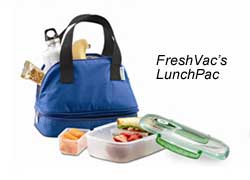 Ice Packs - If you don't have
access to a refrigerator at work or school, keeping food from
getting too warm before lunch time is important. Use small gel packs
designed specifically for use with food, or create your own with
frozen water in zippered plastic bags. Freezing your sandwich or
your lunch's drink provides an additional source of coolness for
your lunch pack. Ice Packs - If you don't have
access to a refrigerator at work or school, keeping food from
getting too warm before lunch time is important. Use small gel packs
designed specifically for use with food, or create your own with
frozen water in zippered plastic bags. Freezing your sandwich or
your lunch's drink provides an additional source of coolness for
your lunch pack.
Food
Containers - Lunch can be one of the most intensive meals for
generating waste. In the fast food world, Styrofoam® clamshells,
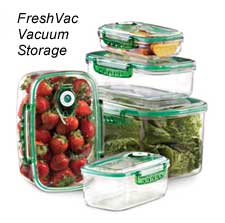 cardboard
packaging, drink containers and individual packaging
of all types easily generates a mountain of trash. A modest
investment in great food containers not only saves on trash, but
creates a pleasant meal experience. Throw in a cloth napkin and
create some thrifty elegance! cardboard
packaging, drink containers and individual packaging
of all types easily generates a mountain of trash. A modest
investment in great food containers not only saves on trash, but
creates a pleasant meal experience. Throw in a cloth napkin and
create some thrifty elegance! 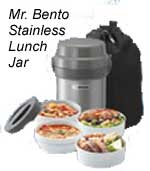 Containers
from other cultures are interesting and practical. Seek out Indian
tiffin tins or Japanese Bento boxes. Containers
from other cultures are interesting and practical. Seek out Indian
tiffin tins or Japanese Bento boxes.
Silverware - Pack the real stuff!
It's environ-friendly and so much nicer to dine with than flimsy
plastic versions that break when spearing a cherry tomato. If you're
cramped for space in your lunch pack, a "spork" might be your
answer! |
Knives 101 - Part Two of
Two
|
Last issue we
discussed the basic parts of every knife. In this issue we uncover
the reasons for the many shapes of knives and how to choose the
right knife for the task at hand. If you've perused our knife
display cases, the different shapes of knives and their blades can
be confusing. Each knife has been designed with specific tasks in
mind with the shape of the blade directly related to the knife's
function. For our discussion we'll categorize knives into four
types:
Slicing
Knives - As the name implies, these knives are for
slicing and cutting a variety of foods. They may have one of four
edges:
- Straight
edges are for normal slicing. The blade should be no more
than 1/8-inch thick and no taller than 1-1/2-inches high.
- Serrated
edges should be used for softer foods such as, bakery items
and some fruits and vegetables.

- Scalloped
edges (the reverse of a serrated edge) is also used for
softer foods and occasionally semi-frozen meats being sliced
thinly as in the case of stir-fry preparation.
- Hollow
edges, sometimes termed a Granton® edge, are for slicing
thick cuts of meat or other foods where the face of the cut
surface might tend to crumble or stick to the knife as with cheese
and many processed meats.
Chef or Cook's Knives - This is the
basic kitchen knife and is sometimes categorized as a "chopper."
These knives are tapered from point to handle. They should be at
least 2 inches high with 6 to 12 inches of  blade
length. The 8-inch blade size is the most popular length, though the
10-inch blade is the preference of most professionals. This knife is
used for chopping and slicing vegetables and fruits, and for mincing
and dicing tasks. A chef's knife is one of the most important knives
you can own. blade
length. The 8-inch blade size is the most popular length, though the
10-inch blade is the preference of most professionals. This knife is
used for chopping and slicing vegetables and fruits, and for mincing
and dicing tasks. A chef's knife is one of the most important knives
you can own.
Fine-work
Knives - This group of knives includes paring knives of all
types. These knives are used for peeling, cutting out gristle from
 meats,
or removing bad spots from foods. Choose a blade length that you are
most comfortable with in your hand and for the task. Boning knives
and fillet knives fall into this category and usually sport a
narrow, flexible blade that is quite handy when deboning meat, fowl,
or fish. meats,
or removing bad spots from foods. Choose a blade length that you are
most comfortable with in your hand and for the task. Boning knives
and fillet knives fall into this category and usually sport a
narrow, flexible blade that is quite handy when deboning meat, fowl,
or fish.
Special Use
Knives -  This
grouping of knives includes cleavers, Asian chef's knives such as
Santokus, garnishing knives, and other very, task-specific
knives. This
grouping of knives includes cleavers, Asian chef's knives such as
Santokus, garnishing knives, and other very, task-specific
knives.
A basic cutlery set-up should start with a Chef's knife (8 or 10-inch), a
Paring knife (2 ½ - 3 ½
-inch), a Serrated Slicer or Bread
Knife, and a Slicing
Knife (8 to 10-inch blade). Buy the best knives you can
afford adding to your collection when you can. Take care of your
knives and they will reward you with years and years of
service!
|
Q &
A's
|
 Q: How does a thermos
work? Q: How does a thermos
work?
A: Hot foods or cold
foods all move toward room temperature. A thermos provides
insulation around the food in the form of a vacuum or foam
insulation neither of which transfer heat in or out very well; the
hot or cold temperature of the food is retained. To maximize the
insulating thermos' capabilities, prime the thermos with very hot
water, or ice water; let set for 5 minutes to allow the temperature
to 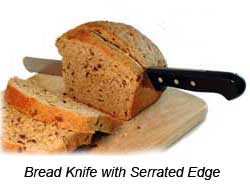 permeate
the inside of the thermos. Then fill with the very hot or very cold
foods. A good thermos properly prepared will keep foods safe for
several hours. permeate
the inside of the thermos. Then fill with the very hot or very cold
foods. A good thermos properly prepared will keep foods safe for
several hours.
Q: How
is a bread knife sharpened?
A: Bread knives, like other
knives, have a serrated edge. This dimpled edge, which is so useful
for grabbing the food when cutting, is beyond the capabilities of
the average sharpener. Each indentation must be sharpened
individually with the proper tool by professionals trained on
serrated edges.  The
good news is that, used properly for the right task, your bread
knife will rarely require sharpening. The
good news is that, used properly for the right task, your bread
knife will rarely require sharpening.
Q: What food safety rules apply to
packed lunches?
A: Keep hot foods hot, and
cold foods cold! It's recommended that food not sit at room
temperature for more than 2 hours. If the temperature is 90°F or
more, then only 1 hour. Pack foods in insulated containers or bags
that retain the hot or cold temperatures of the food. Leave your
lunch in the refrigerator overnight or until you're ready to leave
the house. Take care during lunch preparation not to introduce
bacteria to your food with any cross-contamination. Lunch meat, once
the package is opened, should be eaten within 3-4 days.
Q: What is the recent controversy
over unsafe plastic bottles?
A: Some plastics used in
water and juice bottles degrade when reused over and over again
potentially producing bisphenol A - (BPA). Opt for plastic water
bottles that are BPA-free or units constructed of stainless steel
for your reusable water
bottle.
|
Cookbook
Review
|
'wichcraft
by Tom Colicchio and Sisha Ortúzar. Text by Rhona Silverbush,
Photographs by Bill Bettencourt. Copyright 2009. Published by
Clarkson Potter/Publishers, an imprint of the Crown Publishing
Group, a division of Random House, Inc., New York, NY.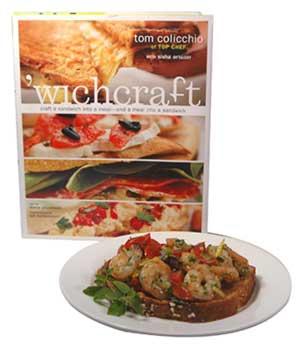
The
clever name and the sumptuous photographs had us falling in love
with this cookbook immediately! Tom Colicchio, of Bravo's "Top Chef" show and his business
partner, Sisha Ortuz, started a 'wichcraft restaurant in New York
with the idea that a great sandwich would be appreciated and sought
after. They were right, twice - through the restaurant and through
this recently released book. The cookbook goes a long way in solving
the conundrum of creating interesting sandwiches, yet ones that are
accessible in the home kitchen. The book is organized around
breakfast sandwiches, cool sandwiches, warm sandwiches, and sweet
sandwiches. Between each category, useful tips on building a great
pantry, bread basics, party fare and many more topics are presented.
The be'wiching thing about this book is the exquisitely devised
recipes where the ingredients perfectly complement each other. With
innovation and creativity applied to the humble sandwich, Colicchio
and Ortúzar have broken new ground on our behalf and to our great
satisfaction.
|
Recipes for Fabulous
Sandwiches
|
Reprinted with permission from 'wichcraft by Tom
Colicchio and Sisha Ortúzar, Text by Rhona Silverbush, Photographs
by Bill Bettencourt. Copyright 2009. Published by Clarkson
Potter/Publishers, an imprint of the Crown Publishing Group, a
division of Random House, Inc., New York, NY. Copyright 2009. All
rights reserved.
Gruyère with
Caramelized Onions
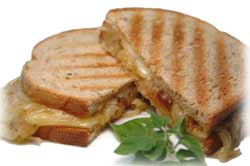
You'll
never think of a "grilled cheese sandwich" in the same way again!
The piquant cheese choice of Gruyère paired with the sweetness of
the slowly cooked onions fashioned a sandwich where every bite was
savored. The extra sandwich we made at suppertime, reheated nicely
for lunch the next day doubling our enjoyment.
Click here to view the full
recipe.
Click here for a printable version of
the recipe.
Roasted Shrimp
Salad with Tomatoes and Olives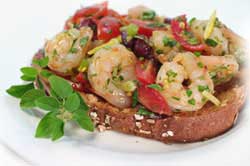
The
authors described this shrimp salad (no mayo here!) as a shrimp
scampi sandwich. We couldn't agree more. The fresh vegetables and
herbs accentuated the garlicky shrimp. Heaped on toast that had been
gently rubbed with garlic, there was almost a panzanella aspect to
this recipe. The open-faced sandwich assembled easily for a
better-than-average lunch.
Click here to view the full
recipe.
Click here for a printable version of
the recipe.
Roasted Pork
Loin with Prunes, Dandelion Greens, and Mustard
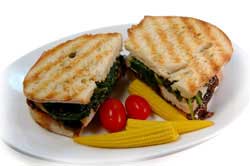 This
sandwich proved to be a hearty supper meal with a perfect blend of
great complex tastes that were easy to recreate. The seared pork
tenderloin was complemented with the mustardy sweetness of the
plums. We substituted spinach for the dandelion greens and enjoyed
the garlic and vinegar flavorings of the greens with each bite of
the sandwich. The extra fixings made a great lunch the following
day. This
sandwich proved to be a hearty supper meal with a perfect blend of
great complex tastes that were easy to recreate. The seared pork
tenderloin was complemented with the mustardy sweetness of the
plums. We substituted spinach for the dandelion greens and enjoyed
the garlic and vinegar flavorings of the greens with each bite of
the sandwich. The extra fixings made a great lunch the following
day.
Click here to
view the full
recipe.
Click here for a printable version of
the
recipe.
| |